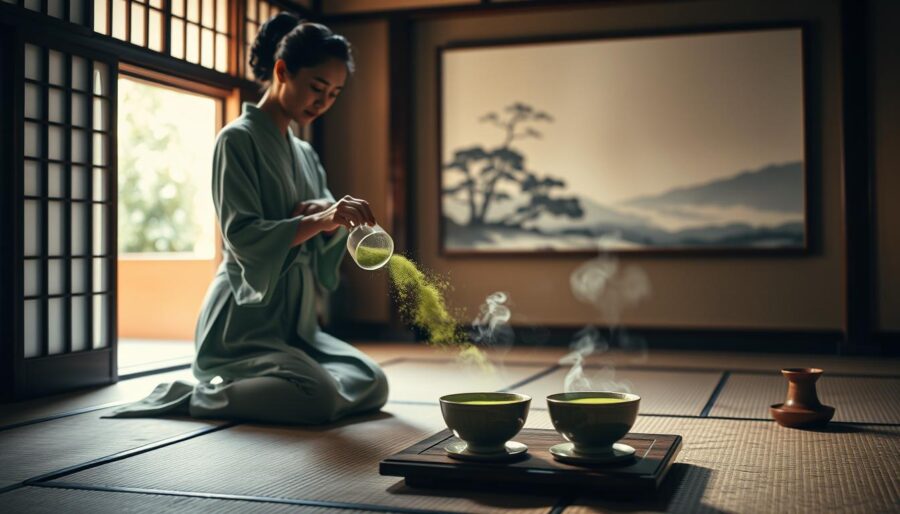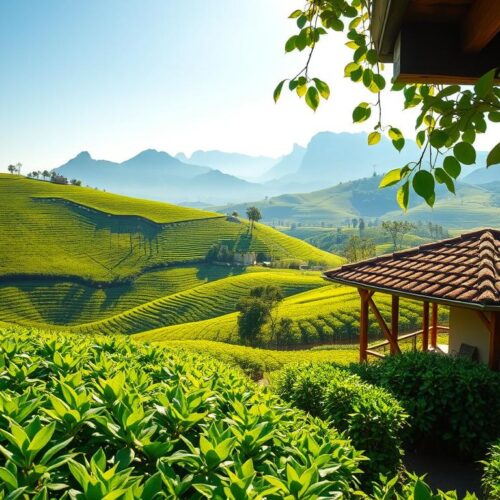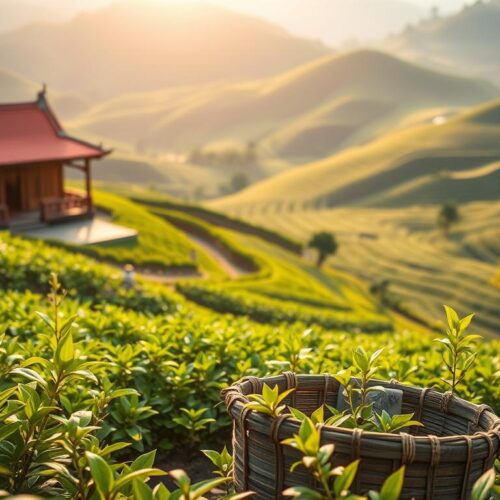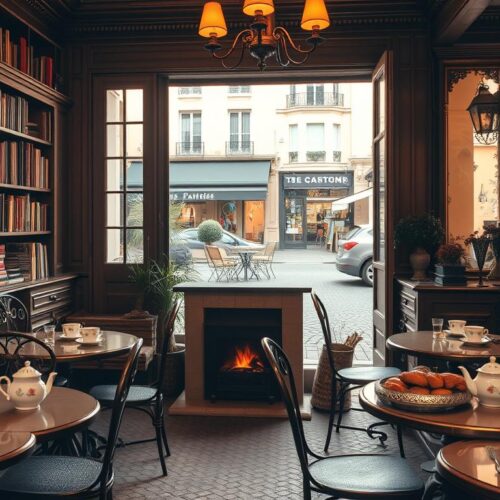You arrive, take off your shoes, and step into calmness. The Japanese tea ceremony is a bridge to traditional culture. Watching steam rise from a kettle, you hear the whisk of matcha. Each movement is made slowly, deliberately, and with great attention.
This practice, known as chadō, sadō, or chanoyu, started with Zen and the principle of wabi-sabi. It was shaped by Sen no Rikyu in the 16th century. Its style values simplicity, where even a cracked bowl shows beauty. You find harmony, respect, purity, and peace in the host’s bow, in turning the bowl, and in how the season is reflected in wagashi.
Traveling Japan offers chances to experience a tea ceremony in Kyoto’s temples, Tokyo’s gardens, and Shizuoka’s tea fields. You can find guidance in places like Kodaiji Temple, Camellia Tea House, and Happo-en. Even luxury hotels like Aman Tokyo and Hoshinoya join in. They teach about tools and proper etiquette. Most hosts are family-friendly and even offer vegan options and tea with little or no caffeine.
This guide prepares you for your tea ceremony trip in Japan. It explains how different seasons change the ceremony’s setting, choosing the ro hearth in winter and the furo brazier in summer. You’ll learn where to find the best regional matcha. Whether you’re drawn to Kyoto’s traditions or a rural workshop, there’s a journey out there for you.
Understanding Chado: The Philosophy Behind the Japanese Tea Ceremony
Chado teaches you to slow down and be mindful. It’s based on Zen Buddhism, crafted by Sen no Rikyu. Every action, like whisking matcha, becomes significant. You learn to notice the peace in simple things.
The ceremony is guided by four principles: harmony, respect, purity, and tranquility. Inside a tea room, the tatami mats and shoji screens make the space calm. Decorations like kakemono and chabana add seasonal beauty. This experience connects you to Japanese culture in a real way.
During the ceremony, hosts and guests communicate without words. This is called omotenashi. You respect the tea bowl by turning it properly. Each sip, the appreciation of the bowl’s beauty, and silent thanks are all important. These small acts mean a lot in Chado.
The ceremony’s environment focuses your mind. The natural light and serenity bring you to the moment. Passing the matcha bowl feels special. You become aware of the thought put into each detail and the meaning of quiet moments.
Teachers start with the ceremony’s core meaning and conclude with time for thought. This experience helps you understand yourself and your surroundings better. Chado teaches grace, whether you’re in Kyoto or your own living room.
From Monastery to Mastery: A Brief History of Chanoyu
Chanoyu started in Zen temples’ quiet halls. Here, monks drank powdered tea to stay alert during meditation. By the 12th century, matcha reached Japan with Buddhist pilgrims from China. It went from being a simple aid for monks to a key element of Japanese tea ceremonies.
Tea gatherings quickly moved beyond temple walls. Nobles began to perfect the setting, tools, and atmosphere. In the 16th century, Sen no Rikyu introduced the concept of wabi-sabi. It means appreciating beauty in simplicity and imperfection. His ideas influenced everyone from samurai to common folks, making tea a central part of culture.
There are specific roles for the host and guests in this tradition. They perform precise actions like cleaning utensils, heating water, and mixing matcha. The season plays a critical role, influencing the choice of hearth, kettle, and scroll for the day. This careful attention to detail lives on in Kyoto and beyond.
Now, this tradition has spread worldwide. Urasenke instructors keep it alive from Kyoto to North America. Akihiko Kaji leads the Urasenke Ichimura-kai in Miami. He studies in Kyoto and teaches the art in schools and cultural spots. Through his efforts, Chanoyu grows as it meets new cultures.
Inside the Tea Room: Space, Atmosphere, and Seasonal Design
Stepping into a modest chashitsu, you find soft tatami flooring underfoot. Shoji screens scatter light gently around the room. The space, though simple, radiates warmth, due to its wabi-sabi and Zen influences.
Your focus shifts to the tokonoma, welcoming you with its presence. A seasonal scroll, or kakemono, and a single chabana flower communicate silently but deeply. This setup suggests a hint of poetry, felt even before tea preparation begins.
Seasonal changes influence the room’s center. In winter, a floor-set hearth called ro warms the room steadily. Summer introduces the furo, a portable brazier, lightening the atmosphere. These seasonal shifts subtly influence the room’s feel, noticeable in every breath.
Your approach is deliberate. Washing your hands at the stone basin, you follow a garden path meant to quiet the mind. Muted light and bamboo whispers accompany you. When you finally kneel, your spirit is prepared for the traditional host-guest exchange.
In Kyoto and beyond, similar quiet designs are recreated. Natural light and sparse decoration reflect an ancient teahut’s ambiance. This setup helps visitors understand how the space affects ceremony etiquette and timing during tea journey in Japan.
Every detail in the ceremony has its own story. The ladle’s grain, the kettle’s place, the scroll’s theme, and the flower’s moment unify. Together, they transform the Japanese tea ceremony into a narrative of air, light, and steam.
The Tools of Tea: Essential Chadogu for Matcha Preparation
In the Japanese tea ceremony, each tool plays a vital role. They all work together to create a moment of peace. As you prepare matcha, you’ll feel the warmth and balance in your hands.
Holding the chawan, or tea bowl, lets you feel its heat. A chasen, made from bamboo, helps make the tea smooth. The chashaku scoops the tea, and the natsume or chaire keeps it fresh.
The time of year influences your tool choice. A thicker chawan is better for winter, keeping your tea warm. In summer, a shallower bowl helps cool the tea quicker. Each piece’s design celebrates the beauty of imperfection and time.
The host cleans and sets up before you arrive. Watching this, you understand the importance of every action. This helps you appreciate the smells, sounds, and the way the water mixes with the tea.
The way you prepare matcha affects its taste. Koicha is thick and served in one bowl during formal gatherings. Usucha is lighter and made for each person. Both styles show how changes in water temperature and whisking can alter the drink.
In classes, you learn about each tool’s use and care. Experts teach you to clean the chasen, place the chashaku, and how to drink from the chawan correctly. With time, you become more skilled and find peace in the process.
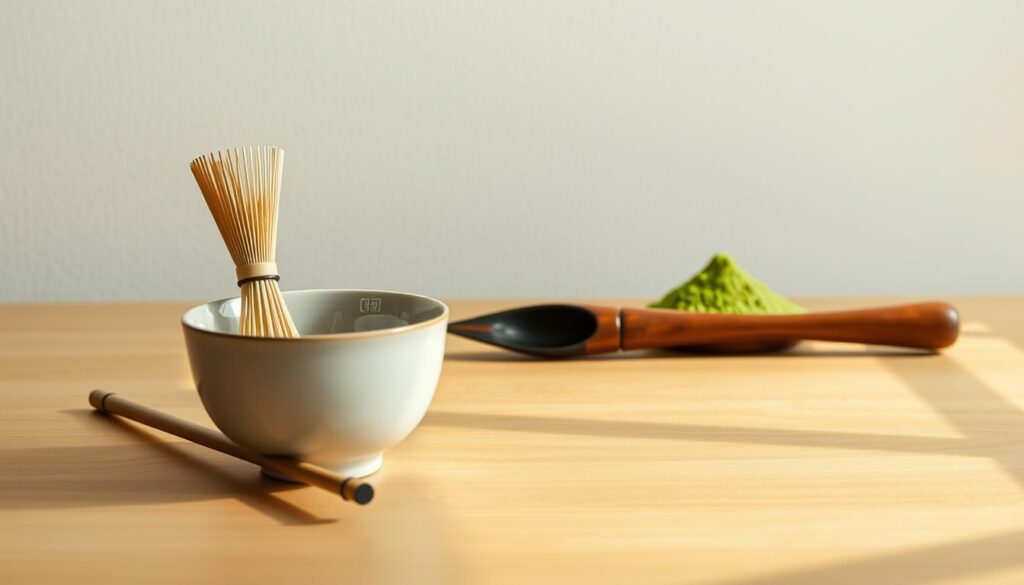
The Ritual Unfolds: Step-by-Step Ceremony Flow
You arrive, take off your shoes, and wash your hands. It prepares you for the ceremony. You bow at the door, feeling the calm room. The peaceful air and soft light set the tea ceremony’s mood.
You start with seasonal sweets. They give wagashi to complement the tea’s taste. Enjoy it slowly, then place your pick on its paper. This sweet beginning prepares you for the flavors to come.
The host carefully cleans each tool. Water heats while matcha is measured. They whisk the tea, making a fine foam. Every move means something, and the quiet lets you see it.
When you get the tea, hold the bowl with both hands and bow. Turn it gently, then take slow sips, usually three. Clean the rim, turn the bowl back, and bow to say thanks.
In a full ceremony, you might share a bowl of thick tea, then have lighter tea. This shows the difference in texture and honors the tradition. It keeps you focused from the first sweet to the last drink.
The season changes the setting and speed. Winter brings a deep calm with a sunken hearth. Summer makes things lighter and quicker with a brazier. These changes in Japan or Kyoto show how surroundings influence us.
They usually explain each step during demonstrations. You watch, then ask questions to learn more. This connects doing and learning, letting you enjoy the tradition without breaking the quiet.
| Phase | Your Role | Host’s Action | Purpose | Seasonal Note |
|---|---|---|---|---|
| Arrival & Purification | Wash hands, bow, settle breath | Welcomes in silence | Marks readiness in the Japanese tea ceremony | Path may feature winter greens or summer flowers in Kyoto |
| Sweets (Wagashi) | Eat before tea, savor | Presents seasonal confections | Balances matcha flavor | Ingredients shift with season and region |
| Utensil Purification | Observe quietly | Cleans bowl, chashaku, natsume | Signals care and respect | Tempo aligns with room temperature and hearth |
| Tea Making | Remain still | Measures matcha, heats water, whisks with chasen | Creates ideal aroma and texture | Ro in winter, furo in summer shape heat and timing |
| Receiving the Bowl | Bow, take with both hands, rotate clockwise | Presents bowl design facing you | Shows etiquette and gratitude | Designs may reflect Kyoto motifs or seasonal themes |
| Sipping | Drink in about three sips | Waits, then collects bowl | Emphasizes mindful tasting | Pace adjusts with climate and occasion |
| Koicha and Usucha | Share, then receive your own bowl | Prepares thick, then thin tea | Contrasts depth and lightness | Menu adapts through the year as you travel Japan |
| Closing | Bow and reflect | Returns tools to order | Restores harmony in traditional culture | Final glance at seasonal flower or scroll |
Etiquette Essentials for Guests
In the Japanese tea ceremony, you can show respect by performing mindful acts. If you get sweets and tea, politely tell the next guest “Osakini (itadakimasu)” indicating you’ll drink first. This gesture respects the host’s effort and follows traditional practices.
To handle the tea bowl, or chawan, correctly, lift it with your right hand and support it with your left. Rotate it slightly towards the right before you drink. Instead of drinking all at once, take small, quiet sips. After drinking, take a moment to admire the bowl’s design, showing your appreciation before placing it back.
If you’re not sure what to do, watch what others do. A gentle bow shows your gratitude to the host. Keep your voice low and move deliberately. These actions will help you fit in, whether you’re at a local event or visiting places like Kyoto, Uji, or Tokyo for a tea ceremony.
For those wanting to experience Japan considerately, being genuine is key. Be prompt, wear clean socks, and skip the strong scents. Whether it’s a school event or a public showcase, your composed attention celebrates the chanoyu’s essence and connects you with Japan’s heritage.
Key phrases to know
- Osakini (itadakimasu): “Excuse me for going ahead.”
- Otemae chodai itashimasu: “Thank you for the preparation.”
- Oishii desu: “It is delicious.”
Types of Gatherings: Chaji, Chakai, and Seasonal Ceremonies
In the Japanese tea ceremony, you’ll find two main styles. Chaji is the formal kind, taking over four hours. It starts with a kaiseki meal. Then, after a short break outside, you come back for koicha, the thick tea, followed by usucha, the thin tea. This ceremony is for big moments and requires patience, good timing, and quiet attention.
Chakai is a more casual experience. It skips the meal and goes straight to enjoying sweets with usucha. This quicker pace is perfect for newcomers or those with little time in Kyoto. It still shows the beauty and precision of the ceremony, but in a more approachable way.
In both Chaji and Chakai, sharing koicha from one bowl brings everyone closer. Usucha is prepared lighter, and everyone gets their own bowl. The host adjusts to fit the guests, the time of year, and the space.
Seasonal rituals are key to this tradition. Winter features a ro, a sunken hearth that heats the space and slows things down. Summer uses a furo, a portable brazier, to bring in air and light. The ceremony changes with the seasons: Tsukimi celebrates moon-viewing in autumn, Hatsugama is the first tea of the New Year, and spring events might be under cherry blossoms.
If you’re going to Kyoto, check the calendar to plan your visit. Choose Chaji for a deep, ceremonial experience. Go for Chakai if you prefer something easy and inviting. Both options offer a glimpse into how the tea ceremony blends season, setting, and community into a singular, serene moment.
Kyoto and Uji: Iconic Destinations for Authentic Experiences
In Kyoto, stepping into the tea ceremony feels like entering the heart of Japan. The quiet paths of Kodaiji Temple guide you to Zen gardens. Here, the seasons change the look of each matcha bowl. At the Camellia Tea House, you’re welcomed to start gently—a perfect spot for learners wanting clear instructions in a tranquil space.
In districts like Gion and Higashiyama, ancient teahouses stand preserved. You can try on a kimono and learn about tea in one go. Each season offers something special—Tsukimi in autumn, ro gatherings in winter, and sakura teas in spring. Thanks to Urasenke teachers, booking either a formal chaji or a casual chakai is simple as you explore Japan.
Uji, to the south, is where you truly connect with tea’s journey from field to cup. Here, you can sample fresh tencha, watch it transform into matcha, and learn to distinguish between different qualities by scent. The Wazukacha Cafe in Wazukacho showcases the largest tencha production in Japan. It’s a place to enjoy green tea, find local teas to bring home, and sometimes participate in matcha art classes.
When planning your tea ceremony trip to Japan, consider starting with short sessions for newcomers and deeper explorations on later visits. Kyoto and Uji both encourage you to slow down. Take a moment in a tea house, watch the steam rise, and notice the harmony between the room, the tools, and the garden. This harmony creates a calming rhythm that stays with you long after your visit.
![]()
Tokyo, Shizuoka, and Beyond: Where Tradition Meets Travel
In Tokyo, neon streets lead to quiet moments. Happo-en Garden hosts the Japanese tea ceremony in an open-air setting. Here, you can enjoy it beside ancient bonsai. In Omotesando, Urasando Garden’s Ujien lets you mix your own matcha. You’ll also learn etiquette, then visit nearby shops and cafés focused on culture.
Luxury places like Aman Tokyo and Hoshinoya Tokyo offer special sessions. There, you sit on tatami mats, carefully hold a chawan, and savor seasonal sweets. These sweets complement the tea’s aroma.
Shizuoka introduces you to the tea’s roots. You’ll ride past green fields to meet tea growers. They’ll lead you through tastings of fresh matcha at the plantations. At Gyokuro-no-Sato, explore the art of making a perfect cup of tea. This includes understanding deep-steamed leaves, proper water temperature, and the timing.
Kanazawa offers a different experience with its Edo-period teahouses. It’s less crowded than Kyoto. In contrast, Mount Koya’s temple lodgings weave tea into morning rituals. This helps you start your day peacefully before exploring trails and halls.
There are also options for those mindful of their budget as they explore Japan. For example, Sankeien Garden in Yokohama has a simple tea ceremony for about 500 yen. This includes a sweet treat and an optional hands-on moment with a tea practitioner. It’s a great way to experience a traditional tea house without feeling rushed.
Tip: Make sure to space out your visits. The calm pace of the Japanese tea ceremony is best enjoyed without hurry.
- City calm: Explore Tokyo gardens and hotels that frame matcha with art and architecture.
- Field to bowl: Visit Shizuoka farms for aroma, terroir, and guided tastings.
- Side paths: Seek Kanazawa teahouses and Mount Koya routines for depth and quiet.
- Smart spend: Choose Sankeien in Yokohama for access, value, and a welcoming tea house.
Japan tea ceremony travel
Plan your trip to a Japan tea ceremony with the seasons in mind. During winter, the warm ro hearth in the room makes things cozy and slow. Come summer, the furo brazier makes the air lighter and cooler. Pick a time to visit when you can see Tsukimi moon-viewing, Hatsugama first kettle, or enjoy sakura gatherings. It’s your chance to experience traditional culture at its best.
Start your journey in Kyoto and Uji to really dive deep into the tradition and craftsmanship. In Kyoto, visit Kodaiji temple for a serene setting where the garden perfectly complements each sip of matcha. Try booking a beginner-friendly session at Camellia Tea House. They teach you the ceremony steps and let you participate as a guest.
Add a touch of modern comfort to your travels in Japan. Stay at hotels in Tokyo, like Aman Tokyo or Hoshinoya, for elegant tea programs. They offer easy-to-follow introductions and times for reflection. Also, visit producers in Shizuoka to see plantations and Gyokuro-no-Sato. It connects you directly to the journey from field to teacup.
Don’t forget to add Uji and Wazukacho to your list. You’ll discover how shading tea plants affects the taste and learn why stone-milled powder is important. Nowadays, many places are welcoming to families. They offer kid-friendly treats and can make vegan wagashi or caffeine-free options if you ask.
Traveling Japan is becoming more accessible for everyone. It’s easier to find tea rooms with ramps and wider entries. If sitting on the floor is tough, hosts can provide stools for comfort. Choose a chaji for a meal and formal experience, or pick a shorter chakai when your schedule is tight.
If you’re interested in a deeper study of the Japanese tea ceremony, consider connecting with groups affiliated with Urasenke. For budget-friendly options, Sankeien Garden in Yokohama is great. Or, for a premium experience, Kyoto offers rare utensils and seasonal kaiseki. Plan a journey that includes peaceful temple visits, hands-on sessions, insights from producers, and reflective tasting.
| Destination | Focus | Seasonal Highlight | Experience Type | Who It Suits |
|---|---|---|---|---|
| Kyoto (Kodaiji, Camellia Tea House) | Temple ambiance, narrated steps, traditional culture | Hatsugama (Jan), cherry blossoms (Mar–Apr) | Guided chakai, beginner lessons | First-time visitors, families, culture seekers |
| Uji and Wazukacho | Tencha and matcha origins, shaded fields | New tea season (May–Jun) | Farm tours, milling demos, tastings | Tea enthusiasts, photographers, learners |
| Tokyo (Aman Tokyo, Hoshinoya) | Refined hotel programs, urban access | Furo summer gatherings (Jun–Aug) | Curated ceremony with translation | Short-stay travelers, design lovers |
| Shizuoka (Gyokuro-no-Sato, plantations) | Producer encounters, cultivation and processing | Harvest visits (Apr–Jun) | Field walks, tastings, pairing | Foodies, origin-focused travelers |
| Yokohama (Sankeien Garden) | Budget-friendly garden teahouse | Tsukimi moon-viewing (Sep–Oct) | Open-air chakai, seasonal sweets | Budget travelers, casual visitors |
- Book sessions that include introductions, narrated steps, guest participation, and time to reflect.
- Confirm seating options, dietary needs like vegan wagashi, and non-caffeinated tea alternatives.
- Choose chaji for formality and depth, or a short chakai to fit a busy travel Japan itinerary.
- Spread visits across Kyoto, Uji, Tokyo, and Shizuoka to balance ritual, comfort, and origin learning.
Following this path, your trip to the Japan tea ceremony honors the season, the place, and the craft of the host. You’ll leave with a vivid sense of how the Japanese tea ceremony is alive today. You’ll see how traditional culture opens up to welcome every guest.
How to Participate: Workshops, Demonstrations, and Inclusivity
You can step into the world of the Japanese tea ceremony at your pace. It often starts with a story of its traditional roots. Then, you witness a demo that explains everything from cleansing tools, measuring the matcha, and whisking it until it’s perfectly foamy. You’ll then get to hold a bowl, learn how to be a good guest, and have a chance to talk about your experience.
Seeking these experiences in Japan can lead you to many places. Whether it’s a bustling district or a serene garden, you can find a spot. Tea houses in places like Asakusa or Kyoto run beginner experiences, and local culture centers are open for anyone to drop by. These sessions offer easy instructions, basic moves, and a chance to really taste and understand the tea.
Sessions are designed to meet what you need. There are options like vegan treats, decaf drinks or teas with less caffeine, and spaces that everyone can enter easily. Events designed for families allow kids to explore the tools and enjoy the treats without feeling rushed.
- Observe: Sit close, watch each step, and note how water, cloth, and bowl move in harmony.
- Try: Whisk your own matcha under guidance, then practice the bow, turn, and sip.
- Reflect: Share what you sensed, from aroma to sound, and clarify etiquette.
Certain places make it simple to jump in when in Japan. Sankeien Garden in Yokohama has an inexpensive ceremony that includes sweets and a moment to try making your own tea. In Tokyo, Urasando Garden’s Ujien offers a laid-back workshop in a cozy spot. Wazukacha Cafe in Kyoto can let you experiment with matcha art, merging creativity with tradition.
Starting at home? Global experts like Akihiko Kaji are there to help. Licensed in 2016, now president of Urasenke Ichimura-kai in Miami, he teaches all year and goes back to Kyoto to learn more. This way, you can learn the basics near you before diving deeper in Japan.
| Experience Type | What You Do | Where to Find It | Accessibility & Options | Best For |
|---|---|---|---|---|
| Guided Demonstration | Watch purification, measuring, and whisking; receive tea with etiquette | Japanese gardens and culture centers | Wheelchair access, seating support, non-caffeinated choices | First-time visitors and families |
| Hands-On Workshop | Whisk matcha, handle utensils, practice bows and turns | Tea house venues in Asakusa, Kyoto, and Uji | Vegan wagashi, language support, small groups | Travelers seeking practical skills |
| Creative Session | Explore powdered green tea art with guided instruction | Wazukacha Cafe, Kyoto | Short lessons, kid-friendly options | Visual learners and families |
| Community Class Abroad | Study core etiquette and seasonal themes over time | Urasenke Ichimura-kai, Miami (Akihiko Kaji) | Regular schedule, introductory loaner tools | Ongoing learners planning to travel Japan |
| Garden Ceremony | Join a serene sitting with sweets and tea in nature | Sankeien Garden, Yokohama | Clear signage, budget-friendly entry | Calm seekers and photo enthusiasts |
Before you head out, make sure to check the times, language help, and food options. Bring an open mind, get there a little early, and dress comfortably for sitting on tatami mats. By doing this, your time with matcha turns into a meaningful experience, connecting you to tradition in a welcoming space.
Conclusion
The journey through a Japanese tea ceremony shows how Zen beliefs shape our daily actions. You’ve witnessed how harmony, respect, purity, and tranquility unfold. From the quiet room where it’s held to the sound of matcha being whisked, every moment is meaningful. Learning about chaji and chakai, and how the ceremonies change with the seasons, prepares you to participate gracefully. Simple gestures, like saying “Osakini”, turning the bowl, and caring for tools, become thoughtful habits. These practices enrich your experiences as you explore Japan and other places.
When planning your tea ceremony trip in Japan, pick places that fit your speed. In Kyoto, you can visit temples and teahouses that promote a space of reflection. Uji offers fields and workshops that connect you to the craft of making tea. In Tokyo, enjoy luxury spots in the city, and in Shizuoka or Gyokuro-no-Sato, discover the tea’s journey from leaf to bowl. Looking for peace? Try Kanazawa’s historic areas or the retreats at Mount Koya, where tradition blends with everyday life.
Look for tea ceremonies that combine action with thoughtful understanding. Being explained what you’re experiencing deepens the connection to the taste of the matcha and the quiet moments in between. Hosts often welcome families and can meet all kinds of needs, ensuring you participate without worry. Join in special events like a moon-viewing, the first tea of the New Year, or a serene moment next to a bonsai. Each ceremony is a chance to pause and reflect on the moment.
Bring that sense of peace back with you. Make tea with purpose, clean with honor, and let each cup remind you of the changing seasons. As you keep exploring Japan or learning from skilled teachers, you hold onto the Tea Way. With every thoughtful drink, you’re living a practice full of calm and mindfulness.

